日本食品级测试参考 JFSL 370 Section V
- 格式:doc
- 大小:36.00 KB
- 文档页数:3
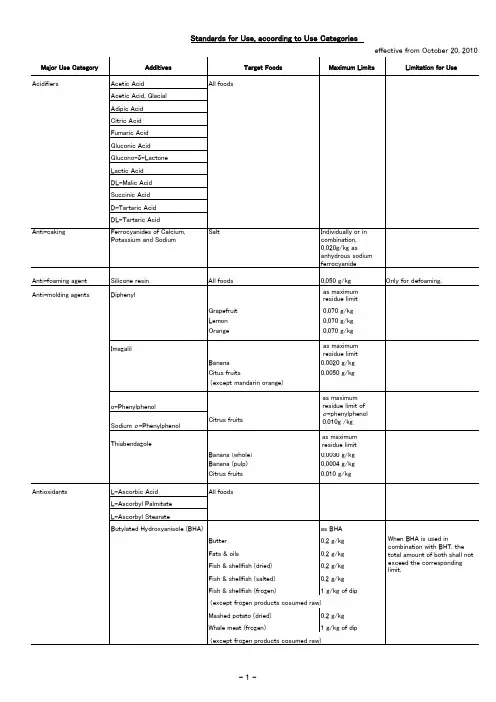
Major Use Category AdditivesTarget FoodsMaximum LimitsLimitation for UseAcidifiersAcetic Acid All foodsAcetic Acid, Glacial Adipic Acid Citric Acid Fumaric Acid Gluconic Acid Glucono-δ-Lactone Lactic Acid DL-Malic Acid Succinic Acid D-Tartaric Acid DL-Tartaric AcidAnti-cakingFerrocyanides of Calcium,Potassium and SodiumSaltIndividually or in combination,0.020g/kg asanhydrous sodium ferrocyanide Anti-foaming agent Silicone resin All foods0.050 g/kg Only for defoaming.Anti-molding agentsDiphenylGrapefruit 0.070 g/kg Lemon 0.070 g/kg Orange0.070 g/kg ImazalilBanana 0.0020 g/kg Citus fruits0.0050 g/kg(except mandarin orange)o-Phenylphenol Sodium o -Phenylphenol Citrus fruitsThiabendazoleBanana (whole)0.0030 g/kg Banana (pulp)0.0004 g/kg Citrus fruits0.010 g/kgAntioxidantsL-Ascorbic Acid All foods L-Ascorbyl Palmitate L-Ascorbyl StearateButylated Hydroxyanisole (BHA)as BHA Butter 0.2 g/kg Fats & oils0.2 g/kg Fish & shellfish (dried)0.2 g/kg Fish & shellfish (salted)0.2 g/kg Fish & shellfish (frozen)1 g/kg of dip(except frozen products cosumed raw)Mashed potato (dried)0.2 g/kg Whale meat (frozen)1 g/kg of dip(except frozen products cosumed raw)Standards for Use, according to Use Categorieseffective from October 20, 2010When BHA is used incombination with BHT, the total amount of both shall not exceed the corresponding limit.as maximum residue limitas maximum residue limit as maximum residue limit of o -phenylphenol 0.010g /kg as maximum residue limitAntioxidants Butylated Hydroxytoluene as BHA (continued) (BHT)Butter 0.2 g/kgChewing gum0.75 g/kgFats & oils0.2 g/kgFish & shellfish (dried)0.2 g/kgFish & shellfish (salted)0.2 g/kgFish & shellfish (frozen) 1 g/kg of dip(except frozen productscosumed raw)Mashed potato (dried)0.2 g/kgWhale meat (frozen) 1 g/kg of dipCalcium Disodium as EDTA-CaNa2Ethylenediamine-0.035 g/kgtetraacetateOther canned and bottle foods0.25 g/kgL-Cysteine Monohydro-Breadchloride Fruit juiceDisodium Ethylene-as EDTA-CaNa2 diaminetetraacetate0.035 g/kgOther canned and bottled foods0.25 g/kgErythrobic Acid All foodsIsopropyl CitrateButter0.10 g/kgFats and oils0.10 g/kgGuaiac Resin Butter 1.0 g/kgFats and oils 1.0 g/kgPropyl Gallate Butter 0.10 g/kgFats and oils0.20 g/kgSodium L-Ascorbate All foodsSodium Erythorbate All foodsdl-α-Tocopherol All foodsAntisticking D-Mannitol Candies40 %Chewing gum20 %FURIKAKE (sprinkleover onlyproducts containing granues)RAKUGAN (dried rice-flour cakes)30 %25 %All foods as CHOMIRYO (seasoning)*When BHA is used in combination with BHT, the total amount of both shall not exceed the corresponding limit.(except frozen products cosumed raw)Canned and bottle non- alcoholic beveragesCanned and bottle non- alcoholic beveragesShall be chelated withcalcium ino before thepreparation of the finishedfood.Not permitted for nutritivepurposes in fish pasteproducts (excluding SURIMI)or bread.Only for antioxidizingpurposes in other foods.as monoisopropylcitrateNot permitted for nutritivepurposes in fish pasteproducts (excluding SURIMI)or bread.Only for antioxidizingpurposes in other foods.Only for antioxidizing, exceptwhen included in preparationof β-Carotene, Vitamin A,Vitamin A Esters of FattyAcids, or Liquid Paraffin.TSUKUDANI (food boiled down in soy sauce, only products madeof KONBU (kelp))50 % ofgranules(as maximumresidue limit)* When used in formula withPotassium Chloride andGlutamate for seasoningfoods or enhancing theiroriginal flavor, no limits arespecified.(only cases where D-Mannitol does not exceed 80% of the sum of PotassiumChloride, Glutamates and D-Mannitol)Color fixativesFerrous Sulfate All foodsPotassium Nitrateless than:Meat products 0.070 g/kg Whale meat bacon0.070 g/kg (as residue limit of NO 2Sodium Nitrate as maximum Sodium Nitriteresidue limit of nitrite Fish ham 0.050 g/kg Fish sausage0.050 g/kg IKURA (salted/processed 0.0050 g/kg salmon roes)Meat products0.070 g/kg SUJIKO (salted salmon roes)0.0050 g/kg TARAKO0.0050 g/kg Whale meat bacon 0.070 g/kg Color adjuvant Ferrous GluconateTable olive0.15 g/kgDietary SupplementsL-Ascorbic acid 2-glucoside All foodsBiotin Foods with health claims Bisbentiamine All foodsCalcium Carbonate*as Ca Calcium Chloride All foods1.0 %Calcium Citrate Chewing gum*10 % *Calcium Dihydrogen Pyrophosphate Calcium Dihydrogen PhosphateCacium GluconateCalcium Glycerophosphate Calcium HydroxideCalcium Lactate Calcium Monohydrogen All foodsPhosphateCalcium Pantothenate Calcium SulfateCholecalciferolAll foodsSame as for Potassium NitrateThe above limits do not apply to foods approved to be labeled as "special. dietary use."Only when indispensable for manufacturing or processing the food, or when used for nutritive purposes.* Only applied to Calcium CarbonateMay also be used as dietary supplement.See the section, "Dietary supplements"Only for nutritive purposes.Only when indispensable for manufacturing or processing the food, or when used for nutritive purposes.Only when indispensable for manufacturing or processing the food, or when used for nutritive purposes.Only when indispensable for manufacturing or processing the food, or when used for nutritive purposes.May be used as fermentation regulator. See the section,"Miscellenous."Dietary Supplements Copper Gluconateas copper(continued)Substitutes for human milk0.60 mg/LFoods with health claims5 mg/recommended daily portion of each foodCupric Sulfateas copper Substitutes for human milk0.60 mg/LDibenzoyl Thiamine All foodsDibenzoyl Thiamine Hydrochloride Dry Formed Vitamin A ErgocalciferolFerric Ammonium Citrate Ferric Chloride Ferric Citrate Ferric Pyrophosphate Ferrous GluconateDried milk for pregnant and lactating women.Substitutes for human milk.Weaning foodsFolic AcidAll foodsL-Histidine Monohydro- chloride Iron Lactate L-Isoleucine L-Lysine L-Aspartate L-Lysine L-GlutamateL-Lysin Monohydrochloride DL-Methionine L-Methionine Methyl Hesperidin Nicotinamide Nicotinic Acid L-Phenylalanine All foodsPyridoxine Hydrochloride RiboflavinRiboflavin 5'-Phosphate SodiumRiboflavin Tetrabutyrate Sodium Ferrous Citrate Sodium Pantothenate Thiamine Dicetylsulfate Thiamine Dilaurylsulfate Thiamine Hydrochloride Thiamine Mononitratewhen formulated into a standard concentration.The limit does not apply to cases where these additives are used in formulated dried milk under approval by the Minister of Health, Labor and Welfare.Not permitted in freshfish/shellfish (including fresh whale meat) or meat.May also be used as color adjuvant.See the section, "Color adjuvant."when formulated into a standard concentration.The limit does not apply to cases where these additives are used in formulated dried milk under approval by the Minister of Health, Labor and Welfare.Dietary Supplements Thiamine Naphthalene-All foods(continued) 1, 5-disulfonateThiamine ThiocyanateDL-ThreonineL-Threonineall-rac-α-Tocopheryl Acetate Foods with health claims as α-TocopherolR,R,R-α-Tocopheryl Acetate150mg/recommendeddaily portion of eachfoodTricalcium Phosphate All foods as Ca1.0 %DL-Tryptophan All foodsL-TryptophanL-ValineVitamin AVitamin A Esters ofFatty AcidsVitamin A in OilZinc Gluconate Only substitutes for human milk as zincFoods with health claims15 mg/recommended dailyportion of each foodZinc Sulfate Only substitutes for human milk as zincEmulsifiers Calcium Strearoyl Lactylate as Calcium Strearoyl LactylateBread. 4.0 g/kgButter cakes. 5.5 g/kgConfections(baked or fried wheatflour products only).4.0 g/kgMoist cakes (rice flour products only).6.0 g/kgMacaroni and other such products.* 4.0 g/kg**as dry noodles.Mixed powder:for manufacturing bread. 5.5 g/kgfor manufacturing confections(fried wheat flour products only).5.5 g/kgfor manufacturing confections(baked wheat flour products only).5.0 g/kgfor manufacturing moist cakes(rice flour products only).10 g/kgfor manufacturing sponge cakes,butter cakes and steamed breads.8.0 g/kgfor manufacturing steamed MANJYU (bun made by steaming wheat flour dough).2.56.0 mg/LWhen formulatedinto a standardconcentration.Not applied to cases whereOnly when indispensable formanufacturing or processingthe food, or when used fornutritive purposes.The above limit donot apply to foodsapproved to belabeled as"special. dietaryuse."6.0 mg/LWhen formulatedinto a standardconcentration.the additives is used in for-mulated dried milk underapproval by the Minister ofHealth, Labor and Welfare.Not applied to cases wherethe additives is used in for-mulated dried milk underapproval by the Minister ofHealth, Labor and Welfare.When used in combinationwith calcium strearoyllactylate and sodiumstrearoyl lactylate, totallevel of the additives ascalcium strearoyl lactylateshall not be more than themaximum limit.Emulsifiers Calcium Strearoyl Lactylate Noodles (excluding instant noodles and dry noodles) 4.5 g/kg**** as boiled noodles.(continued)(continued)Sponge cakes.5.5 g/kg Steamed bread (bread made by steaming wheat flour dough). 5.5 g/kg Steamed MANJYU2.0 g/kgGlycerol Esters of Fatty All foodsAcids LecithinPolysorbate 20as polysorbate 80Polysorbate 60 Capsule- and tablet-form foods excluding confections 25 g/kg Polysorbate 65 Chewing gum5.0 g/kg Polysorbate 80Cocoa and chocolate products 5.0 g/kg Milk-fat substitutes 5.0 g/kg Sauces5.0 g/kg Seasonings for instant noodles 5.0 g/kg Shortening5.0 g/kg Bakery confections3.0 g/kg Decorations for confections 3.0 g/kg (Sugar coatings and icings) Dressing 3.0 g/kg Ice creams 3.0 g/kg Mayonnaise3.0 g/kg Mix powder for bakery confections and moist sweet cake3.0 g/kg Moist sweet cake, unbaked cake 3.0 g/kg(Including fruit tart, cream cake, rare cheese cake, custard pudding, and like products)Sweetened yoghurt 3.0 g/kg Candies1.0 g/kg Edible ices including sherbet 1.0 g/kg Flour paste* 1.0 g/kg Soup1.0 g/kg Pickled sea weed 0.50 g/kg Pickled vegetables 0.50 g/kg Chocolate drinks 0.50 g/kg Unripened cheese0.080 g/kg Canned and bottled sea weed 0.030 g/kg Canned and bottled vegetables 0.030 g/kg Other foods 0.020 g/kgPropylene Glycol Esters All foodsof Fatty AcidsSodium Stearoyl Lactylate Sorbitan Esters of Fatty All foodsAcidsSucrose Esters of Fatty AcidsFilm-forming agentsMorpholine Salts of Fatty Acids Rind of fruits Polyvinyl Acetate*Rind of vegetablesSodium OleateFlavoring agents AcetaldehydeAll foodsOnly for flavoring.AcetophenoneAliphatic Higher Alcohols (excluding substances generally recognized as highly toxic)If it is used together with one of polysorbate 60, 65, and 80,the sum of each amount used shall be not more than the corresponding maximum levels as polysorbate 80. The above standards are not applied for products that are approved or recognized as foods for special dietary use.Flour paste*: In this list, flour paste is confined to paste products of cocoa andchocolate that are prepared with sugar, fat/oil, powder milk,egg, or wheat flour as secondary ingridients, and pasteurized. They are used as fillings or coatings of bread or bakery confections.* Polyvinyl Acetate may also be used as chewing gum base.See the section, "Chewing gum base."Only as film-forming agent.Same as for Calcium Strearoyl LactylateFlavoring agents Aliphatic Higher Aldehydes(continued) (excluding substancesgenerally recognized ashighly toxic)Alphatic Higher Hydro-All foods Only for flavoring.carbons (excluding sub-stances generally recog-nized as highly toxic)Ally CyclohexylpropionateAlly HexanoateAlly IsothiocyanateAmylalcoholα-AmylcinnamicaldehydeAnisaldehydeAromatic AlcoholsAromatic Aldehydes(excluding substancesgenerally recognized ashighly toxic)BenzaldehydeBenzyl Acetate.Benzyl AlcoholBenzyl Propionated-BorneolButanolButyl AcetateButyl ButyrateButyraldehydeButyric AcidCinnamic AcidCinnamaldehydeCinnamyl AcetateCinnamyl AlcoholCitralCitronellalCitronellolCitronellyl AcetateCitronellyl FormateCyclohexyl AcetateCyclohexyl ButyrateDecanalDecanol2,3-Dimethylpyrazine2,5-Dimethylpyrazine2,6-DimethylpyrazineEstersEthersFlavoring agents Ethyl AcetateAll foods(continued)EthanolYeast extract Vinyl acetate resinEthyl Acetoacetate All foods Only for flavoring.Ethyl Butyrate Ethyl Cinnamate Ethyl Decanoate Mixture of2-Ethyl-3,5-dimethylpyrazine and 2-Ethyl-3,6-dimethylpyrazine Ethyl Heptanoate Ethyl Hexanoate Ethyl Isovalerate 2-Ethyl-3-methylpyrazine 2-Ethyl-5-methylpyrazine Ethyl Octanoate Ethyl Phenylacetate Ethyl Propionate 2-Ethylpyrazine Ethylvanillin 1,8-Cineole Eugenol Fatty AcidsFurfural and its derivatives (excluding substances generally recognized as highly toxic)Geraniol Geranyl Acetate Geranyl Formate Hexanoic Acid Hydroxycitronellal Hydroxycitronellal Di- methylacetalIndole and its derivativesOnly for flavoring, execpt when:1. Used for denaturing ethanol which is used for the removal astringency of persimons, the manufacture of crystalline fructose, the preparation of granules or tablets of spices, or the manufacture of KONNYAKU-KO (Konjac powder), or which is used as a solvent for Butylated Hydroxytoluene of Butylated Hydroxyanisole or as aningredient for the manufacture of vinegar;2. Used for accelerating-yeast-autolysis in the extract (water-soluble fraction obtained by autolysis of yeast;)3. Used as a solvent for vinyl acetate resin.Ethyl Aceteta used in manu-facturing yeast extract shall be removed before the preparation of the finished food.Flavoring agents Ionone(continued)Isoamyl AcetateIsoamylalcohol All foods Only for flavoring.Isoamyl ButyrateIsoamyl FormateIsoamyl IsovalerateIsoamyl PhenylacetateIsoamyl PropionateIsobutanolIsobutyraldehydeIsobutyl PhenylacetateIsoeugenolIsopentylamineIsopropanolIsothiocyanates(excluding substances generallyrecognized as highly toxic)IsovaleraldehydeKetonesLactones(excluding substancesgenerally recognized ashighly toxic)LinaloolLinalyl AcetateMaltoldl-Mentholl-Mentholl-Menthyl AcetateMethyl Athranilate2-Methylbutanol3-Methyl-2-butanol2-MethylbutyraldehydeMethyl CinnamateMethyl N-Methylanthra-nilateMethyl β-Naphthyl Ketone6-Methylquinoline5-Methylquinoxaline2-MethypyrazineMethyl Salicylatep-Methylacetophenoneγ-NonalactoneOctanal2-Pentanoll-PerillaldehydePhenethyl AcetatePhenols(excluding substancesgenerally recognized ashighly toxic)Flavoring agents Phenol Ethers(continued) (excluding substancesgenerally recognized ashighly toxic)PiperonalPropanolPropionaldehydePropionic Acid*Terpene HydrocarbonsTerpineolTerpinyl Acetate5,6,7,8-Tetrahydroquinoxaline2,3,5,6-Tetramethylpyrazine All foods Only for flavoring.Thioethers(excluding substancesgenerally recognized ashighly toxic)Thiols(excluding substances generallyrecognized as highly toxic)2,3,5-Trimethylpyrazineγ-UndecalactoneValeraldehydeVanillinFlour treatment agents Ammonium Persulfate Wheat flour0.30 g/kgBenzoyl Peroxide Wheat flourChloride Dioxide Wheat flourDiluted Benzoyl Peroxide Wheat flour0.30 g/kgPotassium Bromate Bread (only products made of wheat0.030 g/kg of wheatflour) flourFood Colors Annato, water-solubleβ-CaroteneCan be used only as diluted Benzoyl Peroxide by mixing with one ormore of Alum, calcium salts of Phosphoric Acid, Calcium Sulfate, Calcium Carbonate, Magnesium Carbonate, and Starch.Not permitted in fresh fish/ shellfish including (fresh whale meat), KONBU (kelp)/ WAKAME (sea weed) (both Laminariales), legumes/ pulses, meat NORI (laver), tea, or vegetables.Shall be decomposed or removed before the preparation of the finished food.Not permitted in fresh fish/ shellfish (including whale meat), KONBU(kelp)/WAKAME (sea weed) (both Laminariales), legumes/pulses, meat, NORI (laver) (except when gold is used on NORI), tea leaves, or vegetables.* Propionic Acid may also be used as preservative. See the section, "Preser-vatives."Food Colors Copper Chlorophyllas copper (continued)0.0004 g/kgChewing gum 0.050 g/kg Chocolate0.0010 g/kg Fish-paste products 0.030 g/kg (excluding SURIMI)Fruits and vegetables for preserva-0.10 g/kgtion.*KONBU (kelp)0.15 g/kg of dry kelp Copper Chlorophyll Moist cakes (excluding bread with 0.0064 g/kg(continued)sweet fillings or toppings)Food Blue No. 1 (Brilliant Blue FCF) and its Alumi- num LakeFood Blue No. 2 (Indigo Carmine) and its Alumi- num LakeFood Green No. 3 (Fast Green FCF) and its Alu- minum LakeFood Red No. 2 (Amaranth) and its Aluminum Lake Food Red No. 3 (Erythro- sin) and its Aluminum Lake Food Red No. 40 (Allura Red) and its Aluminum LakeFood Red No. 102 (New Coccine)Food Red No. 104 (Phloxine)Food Red No. 105 (Rose Bengale)Food Red No. 106 (Acid Red)Food Yellow No. 4 (Tartra- zine) and its Aluminum LakeFood Yellow No. 5 (Sunset Yellow) and its Aluminum LakeFood colors other than chemically synthesized food additivesIron SesquioxideBanana (stem only)KONNYAKU (konjac)Agar jelly in MITSUMAME (prepared by mixing agar jelly,cut fruits, gree beans, etc. with sugar syrup) packed into cans or plastic containers.* Foods which are processed for preserving, including dried foods, salted foods, pickled foods in vinegar, and preserved foods in syrup.Not permitted in fish pickles,fresh fish/shellfish (including whale meat) KASUTERA (a type of pound cake), KINAKO (roasted soybean flour),KONBU (kelp)/WAKAME (sea weed) (both Laminariales ),legumes/pulses, marmalade,meat, meat pickles, MISO (fermented soybean paste),noodles (including Wantan),NORI(laver), soy sauce,sponge cakes, tea leaves,vegetables, or whale meat pickles.Not permitted in fresh fish/shellfish (including whale meat), KONBU(kelp)/WAKAME (sea weed)(both Laminariales ),legumes/pulses, meat, NORI (laver) (except when gold is used on NORI), tea leaves, or vegetables.Food Colors Preparations of tar colors Same as for Food Blue No. 1.(continued)Sodium Copper Chlorophyllin as copper0.0004 g/kgCandies0.020 g/kg Chewing gum 0.050 g/kg Chocolate0.0064 g/kg Fish-paste products (except SURIMI)0.040 g/kg Fruits and vegetables for preserva-0.10 g/kgtion.*KONBU (kelp)0.15 g/kg of dry kelp Sodium Copper Chlorophyllin Moist cakes (excluding bread with 0.0064 g/kg (continued)sweet fillings or toppings)Syrup0.064 g/kgSodium Iron ChlorophyllinTitanium DioxideHumectant Sodium Chondroitin SulfateFish sausage 3.0 g/kg Mayonnaise 20 g/kg Dressing20 g/kg Insecticide Piperonyl Butoxide Cereal grains0.024 g/kg Non-nutritive Sweeteners Acesulfame PotassiumAn (sweetened bean paste) 2.5 g/kg Confectionary 2.5 g/kg Chewing gum5.0 g/kg Edible ices (including sherbets, 1.0 g/kgflavored ices, and other similar foods)Fermented milk*0.50 g/kg Flour paste 1.0 g/kg .Ice creams1.0 g/kg Jam1.0 g/kg Foods with health claims 6.0 g/kg (only tablets)Lactic acid bacterial bevarages* 0.50 g/kg Milk drinks*0.50 g/kg Miscellaneous alcoholic beverages*0.50 g/kg Moist cakes2.5 g/kg Nonalcoholic beverages0.50 g/kgAgar jelly in MITSUMAME (pre-pared by mixing agar jelly, cut fruits, gree beans, etc. withsugar syrup) packed into cans or plastic containers.* Foods which areprocessed for preserving,including dried foods, salted foods, pickled foods in vinegar, and preserved foods in syrup.Only for coloring.Not permitted in fish pickles,fresh fish/shellfish (including whale meat) KASUTERA (a type of pound cake), KINAKO (roasted soybean flour),KONBU (kelp)/WAKAME (sea weed) (both Laminariales ),legumes/pulses, marmalade,meat, meat pickles, MISO (fermented soybean paste),noodles (including Wantan),NORI(laver), soy sauce,sponge cakes, tea leaves,vegetables, or whale meat pickles.* Applied to dilutions, in the case of concentrated products.These maximum limits do not apply to foods approved to be labeled as special dietary use.Same as for Annato,water-solubleNon-nutritive sweeteners Acesulfame Potassium Pickles 1.0 g/kg (continued)(continued)Sugar substitutes**15 g/kgTare (a dip or sauce mainly for 1.0 g/kgJapanese or Chinese foods)Wine*0.50 g/kgOther foods 0.35 g/kg AspartameDisodium Glycyrrhizinate MISO (fermented soybean paste)Soy sauceSaccharin Chewing gum0.050 g/kgSodium Saccharin as residue limitof sodium saccharineless than:KOZI-ZUKE (preserved in KOJI, 2.0 g/kgfermented riceSU-ZUKE (vinegar-pickled foods)TAKUAN-ZUKE (rice bran-pickledradishes)Nonalcoholic beverages (powdered) 1.5 g/kgKASU-ZUKE (lee-pickled foods) 1.2 g/kgMISO-ZUKE (MISO-pickled foods)SHOYU-ZUKE (soy sauce-pickledfoods)Fish/shellfish (processed, excludingfish paste, TSUKUDANI (foodsboiled down with soy sauce),pickles, and canned or bottledfoods)Processed sea weeds0.50 g/kgSimmered beansSoy sauceTSUKUDANI (foods boiled down withsoy sauce)Edible ices0.30 g/kgFish pasteLactic acid bacterial drinksMilk drinksNonalcoholic beveragesSaucesSyrupVinegarAn (sweetened bean paste)0.20 g/kgFermented milkFlour pasteIce cream productsJamsMISO (fermented soybean paste)Pickles (preserved or pickled foods,excluding those listed in thiscolumn)Confectionary0.10 g/kgCanned or bottled foods, excluding 0.20 g/kgthose listed above.** Products used bydirectly adding to drinks, such as coffee and tea. These maximum limits do not apply to foodsapproved to be labeledas special dietary use.(less than 1.5 g/kg in case of materials for nonalcoholic beverage or lactic acid bacteria drinks or fermented milk product to be diluted not less than 5-fold before use, less than 0.90 g/kg in case of vinegar to be deluted not less than 3-fold before use)Non-nutritive sweeteners D-Sorbitol All foods(continued)Sucralose Chewing gum 2.6 g/kgConfectionary 1.8 g/kgJam 1.0 g/kgLactic acid becterial beverages*0.40 g/kgMilk drinks*0.40 g/kgMiscellaneous alcoholic bverages*0.40 g/kgMoist cakes 1.8 g/kgNonalcoholic beverages*0.40 g/kgSake*0.40 g/kgSake (compounded)*0.40 g/kgSugar substitutes**12 g/kgWine (any kind of fruit wine)*0.40 g/kgOther foods0.58 g/kgXylitol All foodsD-XylosePreservatives Benzoic Acid Caviar 2.5 g/kgMargarine 1.0 g/kgNonalcoholic beverages0.60 g/kgSoy sauce0.60 g/kgSyrup0.60 g/kgButyl p-Hydroxybenzoate as p-hydroxybenzoicacidFruit sauce0.20 g/kgnonalcoholic beverages0.10 g/kgRind of fruits and fruit vegetables 0.012 g/kgSoy sauce0.25 g/LSyrup0.10 g/kgVinegar0.10 g/LCalcium Propionate as propionic acidBread and cakes 2.5 g/kgCheese 3.0 g/kgCalcium Sorbate as sorbic acid0.30 g/kgAN (sweetened bean paste) 1.0 g/kgCandied cherries 1.0 g/kgCheese 3.0 g/kgDried fish/shellfish (excluding 1.0 g/kgsmoking cuttlefish & octopus)Dried prune0.50 g/kgFermented milk (as raw materials for0.30 g/kglactic acid bacterial drinks)Fish-paste products (excluding 2.0 g/kgSURIMI)** Products used by directly adding to drinks, such as coffee and tea.* Applied to dilutions, in the case of concentratedproducts.These maximum limits do not apply to foods approved to be labeled as special dietary use.When the additive is used in margarine with Sorbic Acid, Calcium Sorbate or Potassium Sorbate, or a preparation containing these additives, the total amount of them as benzoic acid and as sorbic acid shall not be more than 1.0 g/kg.When the additive is used in cheese with Sorbic Acid, Potassium Sorbate, or Calcium Sorbate or a preparation containing these additives, the total amount of them as propionic acid and as sorbic acid shall not be more than 3.0 g/kg.AMAZAKE (beverages made fromfermneted rice using KOJI (Asp.oryzae), and confined toproducts to be coonsumed in 3-fold or more dilution.)Cheese: When used incombination with propionicacid, calcium propionate, orsodium propionate, totallevel of the additives assorbic acid and as propionicacid shall not be more than3.0 g/kg.Preservative Potassium Sorbate Flour paste products for bread and 1.0 g/kg (continued)(continued) confectionaryFruit juice (including concentrated 1.0 g/kgfruit juice) for confectionaryFruit paste for confectionary 1.0 g/kgGnocchis 1.0 g/kgJams 1.0 g/kgKASU-ZUKE (lees-pickled foods) 1.0 g/kgKetchup0.50 g/kgKOJI-ZUKE (KOJI (Asp. oryzae)- 1.0 g/kgpickled foods)Lactic acid bacterial beverages (ex-0.050 g/kgcluding sterilized bevarages)Lactic acid bacterial beverages (as 0.30 g/kgingredients of lactic acid bacterialbeverages, excluding sterilizedbeverages)Margarine 1.0 g/kgMeat products 2.0 g/kgMiscellaneous alcoholic beverages 0.20 g/kgMISO (fermented soy bean paste) 1.0 g/kgMISO-ZUKE (MISO-pickled foods) 1.0 g/kgSalted vegetables 1.0 g/kgSea urchin products 2.0 g/kgSHOYU-ZUKE (soy sauce-pickled 1.0 g/kgfoods)Simmered beans 1.0 g/kgSmoked cuttlefish & octopus 1.5 g/kgSoup (excluding potage-type soup)0.50 g/kgSU-ZUKE (vinegar-pickled foods)0.50 g/kgSyrup 1.0 g/kgTAKUAN-ZUKE (rice bran-pickled 1.0 g/kgradish)TARE (a dip or sauce mainly for 0.50 g/kgJapanese or Chinese foods)TSUKUDANI (foods boiled down in 1.0 g/kgsoy sauce)TSUYU (a sauce mainly for Japanese0.50 g/kgnoodles)Whale meat products 2.0 g/kgWine (any kind of fruit wine)0.20 g/kgEthyl p-HydroxybenzoateIsobutyl p-Hydroxybenzoate Isopropyl p-Hydroxybenzoate Same as for Butyl p-Hydroxybenzoate.When the additive is usedin margarine with BenzoicAcid or Sodium Benzoate,the total amount of themas benzoic acid and assorbic acid shall not bemore than 1.0 g/kg.When the additive is used inMISO-ZUKE, the totalamount of Sorbic Acid usedin the product, and SorbicAcid and its salts cntainingin MISO as ingredient shallnot be more than 1.0 g/kg.Preservative NisinAs polypeptide containing Nisin A(continued)Cheese (except processed cheese)0.0125g/kgMeat products Whipped creams Dressing 0.010g/kgMayonnaise Sauces*Fine bakery products 0.00625g/kgProcessed cheeseMISO (fermented soybean paste)0.0050g/kgProcessed eggs productsMoist, unbaked, sweet cakes made maainly of cereal grains or starch**0.0030g/kgPotassium Sorbate Propionic AcidPropyl p -Hydroxybenzoate Sodium Benzoateas benzoic acid Caviar2.5 g/kg 1.0 g/kgMargarine1.0 g/kg Nonalcoholic beverages 0.60 g/kg Soy sauce 0.60 g/kg Syrup0.60 g/kgSodium DehydroacetateButter 0.50 g/kg Cheese 0.50 g/kgMargarine0.50 g/kgSodium Propionate Sorbic Acidas sorbic acid 0.30 g/kgAN (sweetened bean paste) 1.0 g/kg Candied cherries1.0 g/kgSame as for Calcium PropionateSame as for Butyl p-HydroxybenzoateFruit paste and fruit juice (includingconcentrated juice) used for manufacturing confectionary.as dehydroacetic Same as for Calcium PropionateAMAZAKE (beverages made from fermneted rice using KOJI (Asp . oryzae ), and confined to products to be coonsumed in 3-fold or more dilution.)This additive may also be used as flavoring agent.See the section, "Flavoring agents."The maximum use levels are not apply to products permmited or recognized by the Minister of Health,Labour and Welfare as foods for special dietary uses. The foods include five types of products: foods for the ill, milk powder for pregnant and lactating women, formulated milkpowder for infants, foods for the aged, foods for specified health uses.* Sauces refer to all kinds of sauces including Oriental thick Worcester sauce,cheese souce, and ketchup,but excluding fruit sauce and its analogues used for cakes.** They refer to rice pudding and tapioca puding, and their analogues, but excluding Oriental sweet dumplings.Same as for Calcium Sorbate When the additive is used in margarine with Sorbic Acid,Calcium Sorbate orPotassium Sorbate, or a preparation containing these additives, the total amount of them as benzoic acid and as sorbic acid shall not be more than 1.0 g/kg.。

各国食品级测试列表(EU,LFGB,FDA,DGCCRF等随着社会经济的发展,电饭锅,果汁机,咖啡机等各种电子电气食物制作产品的普及给我们的生活带来极大的便利。
人们在注重生活品质的同时,也日益关注食品的安全问题,但往往忽视了与食品相接触材料的安全性。
其实在日常使用中,有害物质可能会从电子产品与食品相接触的的材料中迁移至食品,进而影响人类健康。
该问题已引起各方关注,各个国家也不断出台和更新食品级材料的法律法规,维护消费者安全。
常见的各国食品级法规如下:❖欧盟——EC/1935/2004❖德国——LFGB(原来的LMBG)❖法国——French DGCCRF 2004-64❖美国——FDA CFR 21 parts 170-189❖意大利——D.M.21/03/73❖日本——《日本食品卫生法》第II节食品级测试适用范围:各种和食品接触的材料,包括金属、塑料、硅橡胶、涂层、玻璃、陶瓷、木材、纸张等。
常见食品级材料所涉及的产品包括:◆电饭煲、烤炉、咖啡机等与食品接触的电器产品;◆食品储藏用品、菜板、不锈钢等厨具;◆碗、勺、杯、盘、刀叉等餐具;◆食品包装材料。
各国对食品接触材料的管控不仅仅反映在法规当中,也体现在政府的实际行动当中,各国都有相关的政府机构对产品进行抽查和追踪,一旦发现不合格产品,将公开通报不合格产品,并采取召回、退关等强制行动。
欧洲食品饲料快速预警系统(RASFF)历年公布的预警数据表明,中国(包括大陆地区和香港)已经成为案例通报最为频繁的产品产地,这引起了欧盟各成员国和众多企业的高度关注。
宁波捷通凭借丰富的认证检测经验,长期以来为企业提供全面的食品级材料测试服务,包括塑料、金属、陶瓷、橡胶、不粘涂层等各种产品材质,协助企业确认产品能满足欧盟、美国、日本等国的各项严格要求。
食品级材料实验室测试服务食品级测试服务是通过测试与食品接触的材料(常见的有PP塑料、硅橡胶、不锈钢、陶瓷、玻璃、不粘锅等有机涂层、木头、竹制品等)的化学参数、生物参数以及感官参数,对产品成分和安全性进行分析。
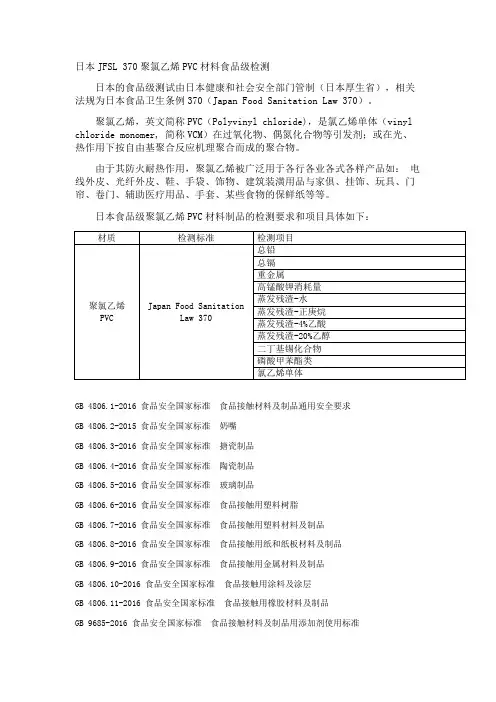
日本JFSL 370聚氯乙烯PVC材料食品级检测日本的食品级测试由日本健康和社会安全部门管制(日本厚生省),相关法规为日本食品卫生条例370(Japan Food Sanitation Law 370)。
聚氯乙烯,英文简称PVC(Polyvinyl chloride),是氯乙烯单体(vinyl chloride monomer, 简称VCM)在过氧化物、偶氮化合物等引发剂;或在光、热作用下按自由基聚合反应机理聚合而成的聚合物。
由于其防火耐热作用,聚氯乙烯被广泛用于各行各业各式各样产品如:电线外皮、光纤外皮、鞋、手袋、饰物、建筑装潢用品与家俱、挂饰、玩具、门帘、卷门、辅助医疗用品、手套、某些食物的保鲜纸等等。
日本食品级聚氯乙烯PVC材料制品的检测要求和项目具体如下:GB 4806.1-2016 食品安全国家标准食品接触材料及制品通用安全要求GB 4806.2-2015 食品安全国家标准奶嘴GB 4806.3-2016 食品安全国家标准搪瓷制品GB 4806.4-2016 食品安全国家标准陶瓷制品GB 4806.5-2016 食品安全国家标准玻璃制品GB 4806.6-2016 食品安全国家标准食品接触用塑料树脂GB 4806.7-2016 食品安全国家标准食品接触用塑料材料及制品GB 4806.8-2016 食品安全国家标准食品接触用纸和纸板材料及制品GB 4806.9-2016 食品安全国家标准食品接触用金属材料及制品GB 4806.10-2016 食品安全国家标准食品接触用涂料及涂层GB 4806.11-2016 食品安全国家标准食品接触用橡胶材料及制品GB 9685-2016 食品安全国家标准食品接触材料及制品用添加剂使用标准-想知道更多食品接触材料检测相关讯息欢迎咨询我们~未经允许,请勿擅自转载-中国GB、欧盟1935/2004/EC、美国FDA、德国LFGB、法国DGCCRF、澳大利亚、意大利、日本、韩国-国家食品接触材料检测重点实验室CNAS、CMA资质检测机构。
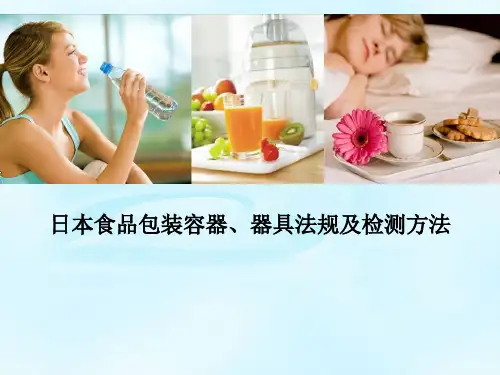
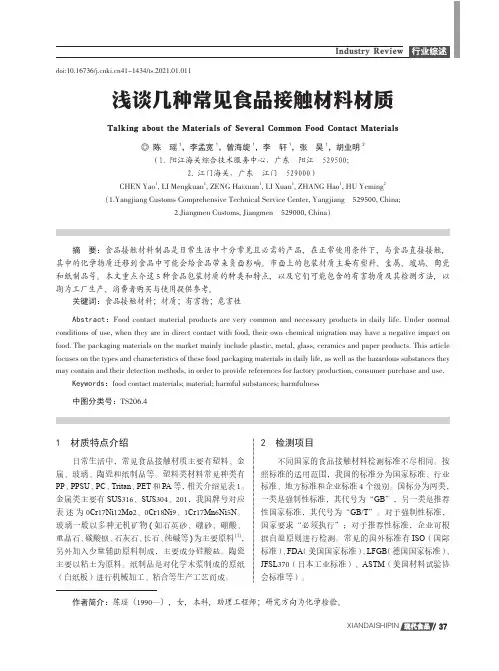
doi:10.16736/41-1434/ts.2021.01.011浅谈几种常见食品接触材料材质Talking about the Materials of Several Common Food Contact Materials◎ 陈 瑶1,李孟宽1,曾海旋1,李 轩1,张 昊1,胡业明2(1.阳江海关综合技术服务中心,广东 阳江 529500;2.江门海关,广东 江门 529000)CHEN Yao1, LI Mengkuan1, ZENG Haixuan1, LI Xuan1, ZHANG Hao1, HU Yeming2(1.Yangjiang Customs Comprehensive Technical Service Center, Yangjiang 529500, China;2.Jiangmen Customs, Jiangmen 529000, China)摘 要:食品接触材料制品是日常生活中十分常见且必需的产品,在正常使用条件下,与食品直接接触,其中的化学物质迁移到食品中可能会给食品带来负面影响。
市面上的包装材质主要有塑料、金属、玻璃、陶瓷和纸制品等。
本文重点介这5种食品包装材质的种类和特点,以及它们可能包含的有害物质及其检测方法,以期为工厂生产、消费者购买与使用提供参考。
关键词:食品接触材料;材质;有害物;危害性Abstract:Food contact material products are very common and necessary products in daily life. Under normal conditions of use, when they are in direct contact with food, their own chemical migration may have a negative impact on food. The packaging materials on the market mainly include plastic, metal, glass, ceramics and paper products. This article focuses on the types and characteristics of these food packaging materials in daily life, as well as the hazardous substances they may contain and their detection methods, in order to provide references for factory production, consumer purchase and use.Keywords:food contact materials; material; harmful substances; harmfulness中图分类号:TS206.41 材质特点介绍日常生活中,常见食品接触材质主要有塑料、金属、玻璃、陶瓷和纸制品等。
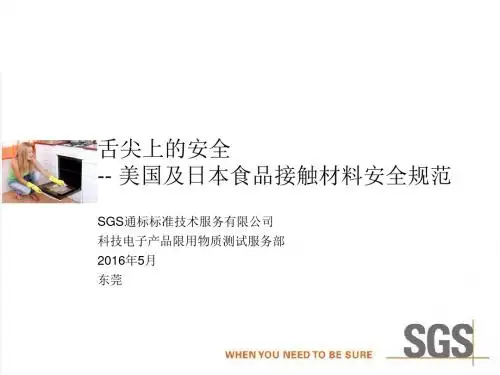

日本JFSL 370聚氯乙烯PVC材料食品级检测日本的食品级测试由日本健康和社会安全部门管制(日本厚生省),相关法规为日本食品卫生条例370(Japan Food Sanitation Law 370)。
聚氯乙烯,英文简称PVC(Polyvinyl chloride),是氯乙烯单体(vinyl chloride monomer, 简称VCM)在过氧化物、偶氮化合物等引发剂;或在光、热作用下按自由基聚合反应机理聚合而成的聚合物。
由于其防火耐热作用,聚氯乙烯被广泛用于各行各业各式各样产品如:电线外皮、光纤外皮、鞋、手袋、饰物、建筑装潢用品与家俱、挂饰、玩具、门帘、卷门、辅助医疗用品、手套、某些食物的保鲜纸等等。
日本食品级聚氯乙烯PVC材料制品的检测要求和项目具体如下:GB 4806.1-2016 食品安全国家标准食品接触材料及制品通用安全要求GB 4806.2-2015 食品安全国家标准奶嘴GB 4806.3-2016 食品安全国家标准搪瓷制品GB 4806.4-2016 食品安全国家标准陶瓷制品GB 4806.5-2016 食品安全国家标准玻璃制品GB 4806.6-2016 食品安全国家标准食品接触用塑料树脂GB 4806.7-2016 食品安全国家标准食品接触用塑料材料及制品GB 4806.8-2016 食品安全国家标准食品接触用纸和纸板材料及制品GB 4806.9-2016 食品安全国家标准食品接触用金属材料及制品GB 4806.10-2016 食品安全国家标准食品接触用涂料及涂层GB 4806.11-2016 食品安全国家标准食品接触用橡胶材料及制品GB 9685-2016 食品安全国家标准食品接触材料及制品用添加剂使用标准-想知道更多食品接触材料检测相关讯息欢迎咨询我们~未经允许,请勿擅自转载-中国GB、欧盟1935/2004/EC、美国FDA、德国LFGB、法国DGCCRF、澳大利亚、意大利、日本、韩国-国家食品接触材料检测重点实验室CNAS、CMA资质检测机构。

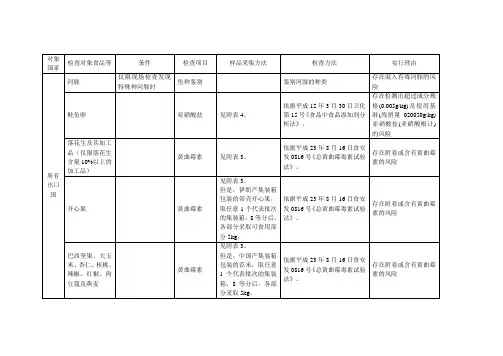
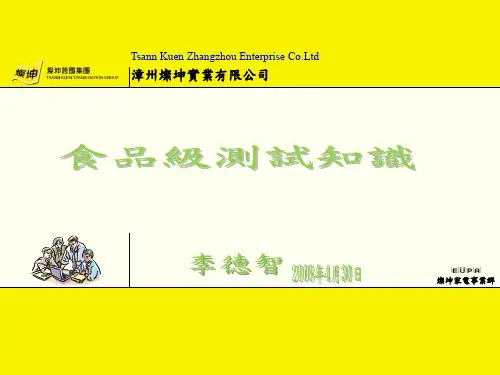
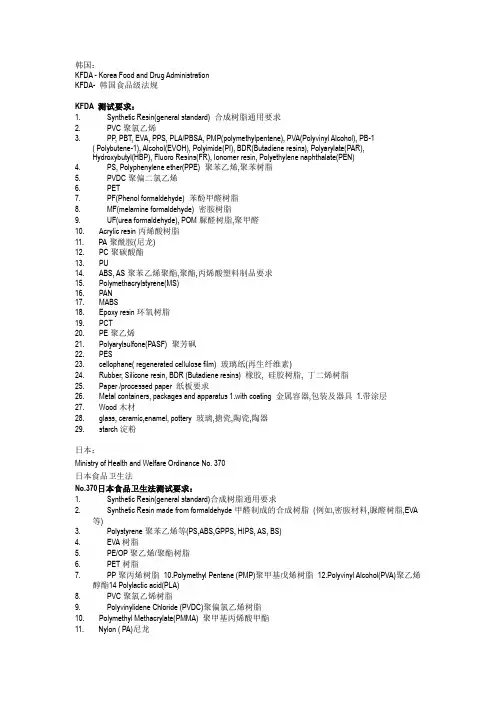
韩国:KFDA - Korea Food and Drug AdministrationKFDA- 韩国食品级法规KFDA 测试要求:1.Synthetic Resin(general standard) 合成树脂通用要求2.PVC聚氯乙烯3.PP, PBT, EVA, PPS, PLA/PBSA, PMP(polymethylpentene), PVA(Polyvinyl Alcohol), PB-1( Polybutene-1), Alcohol(EVOH), Polyimide(PI), BDR(Butadiene resins), Polyarylate(PAR),Hydroxybutyl(HBP), Fluoro Resins(FR), Ionomer resin, Polyethylene naphthalate(PEN)4.PS, Polyphenylene ether(PPE) 聚苯乙烯,聚苯树脂5.PVDC聚偏二氯乙烯6.PET7.PF(Phenol formaldehyde) 苯酚甲醛树脂8.MF(melamine formaldehyde) 密胺树脂9.UF(urea formaldehyde), POM脲醛树脂,聚甲醛10.Acrylic resin丙烯酸树脂11.PA聚酰胺(尼龙)12.PC聚碳酸酯13.PU14.ABS, AS聚苯乙烯聚酯,聚酯,丙烯酸塑料制品要求15.Polymethacrylstyrene(MS)16.PAN17.MABS18.Epoxy resin环氧树脂19.PCT20.PE聚乙烯21.Polyarylsulfone(PASF) 聚芳砜22.PES23.cellophane( regenerated cellulose film) 玻璃纸(再生纤维素)24.Rubber, Silicone resin, BDR (Butadiene resins) 橡胶, 硅胶树脂, 丁二烯树脂25.Paper /processed paper 纸板要求26.Metal containers, packages and apparatus 1.with coating 金属容器,包装及器具1.带涂层27.Wood木材28.glass, ceramic,enamel, pottery 玻璃,搪瓷,陶瓷,陶器29.starch淀粉日本:Ministry of Health and Welfare Ordinance No. 370日本食品卫生法No.370日本食品卫生法测试要求:1.Synthetic Resin(general standard)合成树脂通用要求2.Synthetic Resin made from formaldehyde甲醛制成的合成树脂(例如,密胺材料,脲醛树脂,EVA等)3.Polystyrene聚苯乙烯等(PS,ABS,GPPS, HIPS, AS, BS)4.EVA树脂5.PE/OP聚乙烯/聚酯树脂6.PET树脂7.PP聚丙烯树脂10.Polymethyl Pentene (PMP)聚甲基戊烯树脂12.Polyvinyl Alcohol(PVA)聚乙烯醇酯14 Polylactic acid(PLA)8.PVC聚氯乙烯树脂9.Polyvinylidene Chloride (PVDC)聚偏氯乙烯树脂10.Polymethyl Methacrylate(PMMA) 聚甲基丙烯酸甲酯11.Nylon ( PA)尼龙12.Polycarbonate (PC)13.Phenolic, melamine and urea resins酚醛树脂,密胺和尿素树脂14.Polylactic acid(PLA) 聚乳酸15.Rubber (except nursing utensils) 橡胶制品(除护理用品)16.Rubber (nursing utensils) 橡胶制品(护理用品)17.Metal cans [except those containing dried foods (except fats and oils and fatty foods)] 金属罐(包括盛放油脂和脂肪类食物的容器)18.Metal(Tin for plating)金属(镀锡)19.Metal used for manufacture or repair of apparatus and packaging containers用于制造或修理包装容器和器具的金属20.Solder used for manufacture or repair of apparatus and packaging containers用于制造或修理包装容器和器具的焊锡21.Glass, Ceramic, Enameled玻璃,陶瓷,搪瓷意大利:Italy Official Gazette GU 283 on 30 April 1962 and Ministerial Decree of 21 March 1973意大利与食品接触材料安全法规GU 283-1973/3/21测试要求:1.General plastics 普通塑料2.PC聚碳酸酯3.PVC聚氯乙烯4.Plastic Lid/O-ring/gasket塑料盖、O型圈、垫圈5.PU and PA 聚氨酯和尼龙6.Melamine 三聚氰氨树脂(美耐皿,密胺)制品的要求7.Aluminum and Aluminum alloy 铝和铝合金(Decree No. 76 of 18 April 2007 )8.stainless steel 不锈钢制品Italian Official Gazette (G.U.) DMH 21 March 19739.Wood 木材(参照DGCCRF 2004-64)10.Rubber /Silicone Rubber 橡胶/硅橡胶11.Ceramic 陶瓷Decree of the Ministry of Health of 04-4-1985 (GU no. 120) and 84/500/EC12.Glass 玻璃Italian Official Gazette (G.U.) DMH 21 March 1973法国:French DGCCRF 2004-64 and French Décret nº 92-631DGCCRF法国食品级安全法规DGCCRF 测试要求:1.General Plastic一般塑料制品2.test for plastic lid and O-ring杯盖内塑料垫片或垫圈3.Dyed PU and Nylon 染色的聚胺酯和尼龙4.PVC聚氯乙烯5.Melamine 三聚氰氨树脂(美耐皿,密胺)制品的要求6.Nylon尼龙7.PC聚碳酸酯塑料8.Silicone Rubber 硅橡胶制品要求9.Rubber 橡胶制品要求10.Wood木制品要求11.Paper and paperboard纸制品要求12.Ceramic, Glass, Crystal, vitro ceramic陶瓷,玻璃,水晶制品要求13.Enamelware搪瓷制品要求14.Stainless Steel I: with metal coating II: with organic coating不锈钢制品要求:a. 带金属镀层; b. 带有机涂层15.Aluminum and Aluminum alloy I: with organic coating铝和铝合金制品要求 1.带有机涂层16.Carbon Steel (not for food storage) I: with metal coating II: with Zn plating III: with organic coating17.非贮存食品的碳钢制品要求 1.带金属镀层2. 带锌电镀3.带有机涂层18.Steel for food storage I: with organic coating 用于食物储存的钢铁1.带有机涂层19.Cast Iron I: with metal coating II: with organic coating铸铁制品要求: 1.带金属镀层 2. 带有机涂层20.Tin锡制品要求21.Various other metals (bleached metal), zinc, tin alloy or unknown metal除上述金属制品以外的(浅色)金属,如锌,锡合金和其他金属德国:Germany LFGB (LMBG) Food and Feed Law § 30, 31德国食品级安全法规LFGB 测试要求:1.General Plastic 一般塑料制品或橡胶或有机涂层通用要求2.Test for plastic lid and O-ring 杯盖内塑料垫片或垫圈3.PVC 聚氯乙烯4.Melamine 三聚氰氨树脂(美耐皿,密胺)制品5.PE, PP 聚乙烯,聚丙烯6.PS,ABS, SAN, Acrylic, Methary 聚苯乙烯聚酯,聚酯,丙烯酸塑料制品要求7.PA 聚酰胺(尼龙)制品要求8.PC 聚碳酸酯塑料制品要求9.Poly(threphthalic acid diol esters), PET塑料制品要求10.Acetal resins POM 塑料制品要求11.Silicone rubber 硅橡胶制品要求12.Rubber, TPR, TPE 橡胶或弹性体制品要求13.Paper(not applicable for paper and board used in microwave oven)纸制品要求(不适用于微波炉使用的纸张14.Baking paper 烘焙纸15.PU and TPU 聚胺酯,聚亚胺酯制品要求16.Polymer coating for cooking purpose 有机涂层(烹饪用),例如特富龙17.Wood 木材18.Glass and Enamel ware 玻璃,搪瓷制品要求19.Ceramic 陶瓷84/500/EEC20.Metal, Metal alloy and electroplated(exclude aluminum) 金属、合金、镀层(除了铝)21.Al and Al alloy 纯铝和铝合金22.Textile material 纺织品23.Activated carbon and Charcoal 活性炭、木炭24.Vinylidene Chloride Copolymers with a Predominant Content of (PVDC)偏聚氯乙烯25.Product in contact with mouth lip or mouth cavity directly. eg. Toothbrush, drinking straw会跟嘴直接接触的产品,例如牙刷,吸管26.product in prolonged contact with skin (over 1 hour upon usage) eg. Handle of food roller产品会接触皮肤的把手(使用超过一小时)27.Metallic product in prolonged contact with skin (over 1 hour upon usage) eg. Handle of food roller会接触皮肤的金属产品把手(超过一小时)28.Dyed product in prolonged contact with skin (over 1 hour upon usage) eg. Table napkins染色产品会接触皮肤的延伸部分(使用超过一小时)例如:餐巾29.vacuum thermal bulb used in water canister or water jar真空保温瓶美国:FDA 美国食品级法规U.S.FDA CFR 21 Part 175-189 & FDA CPG 7117.05, 06, 07FDA 测试对象:1.与食品接触的容器2.用于食物储藏的陶器、餐具、锅、盘、厨房用具3.与饮用水接触的材料和零部件4.食品包装材料5.用于食品生产的机器零部件6.其他FDA 测试要求:1.U.S. FDA CFR 21 175.300 有机涂层, 金属和电镀(除了银镀层)制品要求2.U.S. FDA CFR 21 176.170 纸制品要求3.U.S. FDA CFR 21 178.3800 Wood 木材要求4.U.S. FDA CFR 21 177.1010 Acrylic丙烯酸树脂要求5.U.S. FDA CFR 21 177.1210 食品容器的密封圈,密封衬垫要求,如硅橡胶圈6.U.S. FDA CFR 21 177.1350 EVA要求7.U.S. FDA CFR 21 177.1460 for Melamine resins 三聚氰氨树脂(密胺)要求8.U.S. FDA CFR 21 177.1500尼龙塑料要求,如Nylon6, Nylon66, Nylon610, Nylon6/66, Nylon6/12,Nylon12T等(需要确定尼龙类型)9.U.S. FDA CFR 21 177.1520 PP要求10.U.S. FDA CFR 21 177.1520 PE,OP要求11.U.S. FDA CFR 21 177.1580 PC聚碳酸酯要求12.U.S. FDA CFR 21 177.1630 PET要求13.U.S. FDA CFR 21 177.1640 PS 要求14.U.S. FDA CFR 21 177.1655 Polysulfone resin 聚枫树脂要求15.U.S. FDA CFR 21 177.1680 PU聚亚氨树脂要求16.U.S. FDA CFR 21 177.1810 Styrene block polymer 苯乙烯嵌段聚合物要求17.U.S. FDA CFR 21 177.1830 MMA、MBS要求18.U.S. FDA CFR 21 177.1900 Urea-formaldehyde resin UF脲醛树脂要求19.U.S. FDA CFR 21 175.300 / 177.1975 PVC要求20.U.S. FDA CFR 21 177.2420 polyester resin, cross-linked (PETG) 交联聚脂树脂要求21.U.S. FDA CFR 21 177.2450 Polyamide-imide resin 聚酰胺-酰亚胺树脂22.U.S. FDA CFR 21 177.2600 Rubber 橡胶要求,如SBS,TPR,TPE,硅胶等弹性体23.U.S. FDA CPG 7117.05 Silver plated 镀银制品要求24.U.S. FDA CPG 7117.06,07 Ceramic, glass, enamel food ware 陶瓷、玻璃、搪瓷器皿要求25.U.S. FDA CFR 177.2470 /2480 POM聚甲醛共聚26.General Recognized As Safe (GRAS) US FDA stainless steel cutlery不锈钢(非烹饪用具) Cookware Manufacturer Association(CMA)Cookware (烹饪用具) FDA CFSAN PAC for collection No. 04005 & FDA CPG 7117.05 for Brassware or metal ware made ofcopper or coated with copper 黄铜制品、铜制品、镀铜产品29.U.S. FDA CFR 175.300 & CPG 7117.05 other metal product (except silver plated) 其他金属要求(除镀银制品外)欧盟:2011年1月14日欧盟最新(EU)No 10/2011 代替1935/2004,成为目前欧盟与食品接触材料最新安全法规!10/2011 测试要求:1.Plastic material 塑料-2002/72/ECtest for plastic lid and O-ring杯盖内塑料垫片或垫圈dyed PU and PA 染色的PU和尼龙PVC2.Ceramic, Glass and Enamel陶瓷,玻璃和搪瓷- 84/500/EEC (2005/31/EC)3.Silicone Rubber 硅橡胶-AP (2004)54.Melamine 三聚氰氨树脂(美耐皿,密胺)制品的要求anic coating 有机涂层-AP(2004)16.Rubber 橡胶-AP (2004) 4 & 93/11/EEC7.Paper(including baking paper) 纸张(包括烘培纸)-AP (2002)18.Wood木材9.Colourants(in plastic material) 着色剂-AP(89)1英国:UK英国与食品接触材料安全法规测试要求:1.Plastic material 塑料-2002/72/EC2.Ceramic and Glass 陶瓷玻璃-84/500/EEC (2005/31/EC)3.Silicone Rubber 硅橡胶-AP (2004)54.Melamine 三聚氰氨树脂(美耐皿)制品的要求anic coating 有机涂层-AP(2004)16.Rubber 橡胶-AP (2004) 4 & 93/11/EEC7.Paper纸张-AP (2002)18.Wood木材9.Metal, Metal alloy and electroplated 金属,合金和电镀制品。
Major Use CategoryAdditivesTarget FoodsMaximum LimitsLimitation for UseppmAcidifiers Acetic Acid All foodsAcetic Acid, Glacial Adipic Acid Citric Acid Fumaric Acid Gluconic Acid Glucono-δ-Lactone Lactic Acid DL-Malic Acid Succinic Acid D-Tartaric Acid DL-Tartaric AcidAnti-cakingFerrocyanides of Calcium,Potassium and SodiumSaltIndividually or in combination,0.020g/kg asanhydrous sodium ferrocyanide Anti-foaming agent Silicone resin All foods0.050 g/kg Only for defoaming.Anti-molding agentsDiphenylGrapefruit 0.070 g/kg Lemon 0.070 g/kg Orange0.070 g/kg ImazalilBanana 0.0020 g/kg Citus fruits0.0050 g/kg(except mandarin orange)o-Phenylphenol Sodium o -Phenylphenol Citrus fruitsThiabendazoleBanana (whole)0.0030 g/kg Banana (pulp)0.0004 g/kg Citrus fruits0.010 g/kgAntioxidantsL-Ascorbic Acid All foods L-Ascorbyl Palmitate L-Ascorbyl StearateButylated Hydroxyanisole (BHA)as BHA Butter 0.2 g/kg Fats & oils0.2 g/kg Fish & shellfish (dried)0.2 g/kg Fish & shellfish (salted)0.2 g/kg Fish & shellfish (frozen) 1 g/kg of dip(except frozen products cosumed raw)Mashed potato (dried)0.2 g/kg Whale meat (frozen)1 g/kg of dipStandards for Use, according to Use Categorieseffective from October 26, 2007When BHA is used incombination with BHT, the total amount of both shall not exceed the corresponding limit.as maximum residue limitas maximum residue limit as maximum residue limit of o -phenylphenol 0.010g /kg as maximum residue limit (except frozen products cosumed raw)ppm Antioxidants Butylated Hydroxytoluene as BHA (continued)(BHT)Butter0.2 g/kg Chewing gum 0.75 g/kg Fats & oils0.2 g/kg Fish & shellfish (dried)0.2 g/kg Fish & shellfish (salted)0.2 g/kg Fish & shellfish (frozen) 1 g/kg of dip(except frozen products cosumed raw)Mashed potato (dried)0.2 g/kg Whale meat (frozen)1 g/kg of dipCalcium Disodium as EDTA-CaNa 2 Ethylenediamine-0.035 g/kg tetraacetate0.25 g/kgBread Fruit juiceas EDTA-CaNa 20.035 g/kg Other canned and bottled foods 0.25 g/kgErythrobic AcidAll foodsIsopropyl CitrateButter0.10 g/kg Fats and oils0.10 g/kg Guaiac ResinButter1.0 g/kg Fats and oils 1.0 g/kg Propyl GallateButter 0.10 g/kg Fats and oils0.20 g/kgSodium L-Ascorbate All foods Sodium ErythorbateAll foodsdl -α-Tocopherol All foodsWhen BHA is used incombination with BHT, the total amount of both shall not exceed the corresponding limit.(except frozen products cosumed raw)Canned and bottle non- alcoholic beveragesDisodium Ethylene- diaminetetraacetateCanned and bottle non- alcoholic beveragesOther canned and bottle foods Shall be chelated with calcium ino before the preparation of the finished food.Not permitted for nutritive purposes in fish pasteproducts (excluding SURIMI)or bread.Only for antioxidizing purposes in other foods.as monoisopropyl citrate Not permitted for nutritive purposes in fish pasteproducts (excluding SURIMI)or bread.Only for antioxidizing purposes in other foods.Only for antioxidizing, except when included in preparation of β-Carotene, Vitamin A,Vitamin A Esters of Fatty Acids, or Liquid Paraffin.L-Cysteine Monohydro- chlorideppmBleaching agents Other foods (excluding cherry used 0.030 g/kg (continued)for candied cherry, hop used for brewing beer, fruit juice used for manufacturing wine, and squeezed fruit juice containing alcohol of not less than 1 % by volume, and and a concentrate of the same.)Chewing gum basesEster Gum Chewing gumOnly as chewing gum base.Polybutene Polyisobutylene Polyvinyl Acetate*Color fixatives Ferrous Sulfate Potassium Nitrateless than:Meat products 0.070 g/kg Whale meat bacon0.070 g/kg (as residue limit of NO 2Sodium Nitrate as maximum Sodium Nitriteresidue limit of nitriteFish ham 0.050 g/kg Fish sausage0.050 g/kg IKURA (salted/processed 0.0050 g/kg salmon roes)Meat products0.070 g/kg SUJIKO (salted salmon roes)0.0050 g/kg TARAKO0.0050 g/kg Whale meat bacon 0.070 g/kg Color adjuvant Ferrous GluconateTable olive0.15 g/kgDietary SupplementsL-Ascorbic acid 2-glucoside Biotin Foods with health claims Bisbentiamine All foodsCalcium Carbonate*as Ca Calcium Chloride All foods1.0 %Calcium Citrate Chewing gum*10 % *Calcium Dihydrogen Pyrophosphate Calcium Dihydrogen PhosphateCacium GluconateCalcium Glycerophosphate Calcium HydroxideCalcium LactateSame as for Potassium NitrateThe above limits do not apply to foods approved to be labeled as "special. dietary use."Only when indispensable for manufacturing or processing the food, or when used for nutritive purposes.* Only applied to Calcium Carbonate* Polyvinyl Acetate may also be used as film-forming. See the section, "Film-forming agents."May also be used as dietary supplement.See the section, "Dietary supplements"Only for nutritive purposes.Only when indispensable for manufacturing or processing the food, or when used for nutritive purposes.May be used as fermentation regulator. See the section,"Miscellenous."Dietary Supplements Calcium Monohydrogen (continued) PhosphateCalcium Pantothenate All foodsCalcium SulfateCholecalciferol All foodsCopper Gluconateas copperSubstitutes for human milk0.60 mg/LFoods with health claims5 mg/recommended daily portion of each foodCupric Sulfateas copper Substitutes for human milk0.60 mg/LDibenzoyl Thiamine All foodsDibenzoyl Thiamine Hydrochloride Dry Formed Vitamin A ErgocalciferolFerric Ammonium Citrate Ferric Chloride Ferric Citrate Ferric Pyrophosphate Ferrous GluconateDried milk for pregnant and lactating women.Substitutes for human milk.Weaning foods,Folic AcidL-Histidine Monohydro- chloride Iron Lactate L-Isoleucine L-Lysine L-Aspartate L-Lysine L-GlutamateL-Lysin Monohydrochloride DL-Methionine L-Methionine Methyl Hesperidin Nicotinamide Nicotinic Acidwhen formulated into a standard concentration.The limit does not apply to cases where these additives are used in formulated dried milk under approval by the Minister of Health, Labor and Welfare.Not permitted in freshfish/shellfish (including fresh whale meat) or meat.May also be used as color adjuvant.See the section, "Color adjuvant."Only when indispensable for manufacturing or processing the food, or when used for nutritive purposes.Only when indispensable for manufacturing or processing the food, or when used for nutritive purposes.when formulated into a standard concentration.The limit does not apply to cases where these additives are used in formulated dried milk under approval by the Minister of Health, Labor and Welfare.Dietary Supplements L-Phenylalanine All foods(continued)Pyridoxine Hydrochloride RiboflavinRiboflavin 5'-Phosphate SodiumRiboflavin Tetrabutyrate Sodium Ferrous Citrate Sodium Pantothenate Thiamine Dicetylsulfate Thiamine Dilaurylsulfate Thiamine Hydrochloride Thiamine Mononitrate Thiamine Naphthalene-All foods1, 5-disulfonate Thiamine Thiocyanate DL-ThreonineL-Threonineall-rac -α-Tocopheryl AcetateFoods with health claimsas α-Tocopherol R,R,R -α-Tocopheryl Acetate150mg/recommended daily portion of each food Tricalcium PhosphateAll foodsas Ca 1.0 %DL-Tryptophan All foodsL-Tryptophan L-Valine Vitamin AVitamin A Esters of Fatty Acids Vitamin A in Oil Zinc GluconateOnly substitutes for human milkas zinc Foods with health claims15 mg/ recommended daily portion of each foodZinc Sulfate Only substitutes for human milkas zinc Emulsifiers Calcium Strearoyl LactylateBread. 4.0 g/kg Butter cakes.5.5 g/kgConfections (baked or fried wheat flour products only).4.0 g/kg Moist cakes (rice flour products only).6.0 g/kg Macaroni and other such products.* 4.0 g/kg**as dry noodles.6.0 mg/LWhen formulated into a standard concentration.Not applied to cases where the Only when indispensable for manufacturing or processing the food, or when used for nutritive purposes.The above limit do not apply to foods approved to be labeled as "special.dietary use."6.0 mg/LWhen formulated into a standard concentration.additives is used in for-mulated dried milk under approval by the Minister of Health, Labor and Welfare.Not applied to cases where the additives is used in for-mulated dried milk under approval by the Minister of Health, Labor and Welfare.ppm Emulsifiers Calcium Strearoyl Lactylate Mixed powder:(continued)(continued)for manufacturing bread. 5.5 g/kg for manufacturing confections (fried wheat flour products only).5.5 g/kgfor manufacturing confections (baked wheat flour products only).5.0 g/kg for manufacturing moist cakes (rice flour products only).10 g/kg for manufacturing sponge cakes,butter cakes and steamed breads.8.0 g/kg for manufacturing steamed MANJYU (bun made by steaming wheat flour dough).2.5Noodles (excluding instant noodles and dry noodles) 4.5 g/kg**** as boiled noodles.Sponge cakes.5.5 g/kgSteamed bread (bread made by steaming wheat flour dough). 5.5 g/kg Steamed MANJYU2.0 g/kgGlycerol Esters of Fatty All foodsAcids LecithinPropylene Glycol Esters of Fatty Acids Sorbitan Esters of Fatty All foodsAcidsSucrose Esters of Fatty AcidsFilm-forming agentsMorpholine Salts of Fatty AcidsRind of fruits Polyvinyl Acetate*Rind of vegetablesSodium OleateFlavoring agents AcetaldehydeAll foodsOnly for flavoring.AcetophenoneAliphatic Higher Alcohols (excluding substances generally recognized as highly toxic)Aliphatic Higher Aldehydes (excluding substances generally recognized as highly toxic)Alphatic Higher Hydro- carbons (excluding sub- stances generally recog- nized as highly toxic)Ally Cyclohexylpropionate Ally Hexanoate Ally Isothiocyanate Amylalcoholα-Amylcinnamicaldehyde Anisaldehyde Aromatic Alcohols* Polyvinyl Acetate may also be used as chewing gum base.See the section, "Chewing gum base."Only as film-forming agent.ppmFlavoring agents Aromatic Aldehydes All foods Only for flavoring.(continued)(excluding substances generally recognized as highly toxic)Benzaldehyde Benzyl Acetate .Benzyl Alcohol Benzyl Propionated -Borneol ButanolButyl Acetate Butyl Butyrate Butyraldehyde Butyric Acid Cinnamic Acid Cinnamaldehyde Cinnamyl Acetate Cinnamyl Alcohol Citral Citronellal Citronellol Citronellyl Acetate Citronellyl Formate Cyclohexyl Acetate Cyclohexyl Butyrate Decanal Decanol Esters Ethers Ethyl AcetateAll foods (flavoring only)EthanolYeast extractVinyl acetate resinEthyl Acetoacetate All foodsOnly for flavoring.Ethyl Butyrate Ethyl Cinnamate Ethyl DecanoateOnly for flavoring, execpt when:1. Used for denaturing ethanol which is used for the removal astringency of persimons, the manufacture of crystalline fructose, the preparation of granules or tablets of spices, or the manufacture of KONNYAKU-KO (Konjac powder), or which is used as a solvent for Butylated Hydroxytoluene of ButylatedHydroxyanisole or as an ingredient for the manufacture of vinegar;2. Used for accelerating- yeast-autolysis in the extract (water-soluble fraction obtained by autolysis of yeast;)3. Used as a solvent for vinyl acetate resin.Ethyl Aceteta used in manu-facturing yeast extract shall be removed before the preparation of the finished food.ppmFlavoring agents Mixture of(continued) 2-Ethyl-3,5-dimethylpyrazine and2-Ethyl-3,6-dimethylpyrazineEthyl Heptanoate All foods Only for flavoring.Ethyl HexanoateEthyl Isovalerate2-Ethyl-3-methylpyrazineEthyl OctanoateEthyl PhenylacetateEthyl PropionateEthylvanillin1,8-CineoleEugenolFatty AcidsFurfural and its derivatives(excluding substances generallyrecognized as highly toxic)GeraniolGeranyl AcetateGeranyl FormateHexanoic AcidHydroxycitronellalHydroxycitronellal Di-methylacetalIndole and its derivativesIononeIsoamyl AcetateIsoamylalcoholIsoamyl ButyrateIsoamyl FormateIsoamyl IsovalerateIsoamyl PhenylacetateIsoamyl PropionateIsobutanolIsobutyraldehydeIsobutyl PhenylacetateIsoeugenolIsopropanolIsothiocyanates(excluding substances generallyrecognized as highly toxic)KetonesLactones(excluding substancesgenerally recognized ashighly toxic)LinaloolLinalyl AcetateMaltoldl-Mentholl-MentholppmFlavoring agents l -Menthyl Acetate (continued)Methyl Athranilate 2-Methylbutanol Methyl Cinnamate Methyl N -Methylanthra- nilateMethyl β-Naphthyl Ketone 5-Methylquinoxaline Methyl SalicylateOnly for flavoring.p -Methylacetophenone γ-Nonalactone Octanall -Perillaldehyde Phenethyl Acetate Phenols(excluding substances generally recognized as highly toxic)Phenol Ethers(excluding substances generally recognized as highly toxic)Piperonal All foodsPropanol Propionic Acid*Terpene Hydrocarbons Terpineol Only for flavoring.Terpinyl Acetate2,3,5,6-Tetramethylpyrazine Thioethers(excluding substances generally recognized as highly toxic)Thiols(excluding substances generally recognized as highly toxic)2,3,5-Trimethylpyrazine γ-Undecalactone VanillinFlour treatment agentsAmmonium Persulfate Wheat flour 0.30 g/kgBenzoyl PeroxideWheat flourChloride Dioxide Wheat flour Diluted Benzoyl Peroxide Wheat flour0.30 g/kgPotassium BromateBread (only products made of wheat 0.030 g/kg of wheat flour) flour* Propionic Acid may also be used as preservative. See the section, "Preser- vatives."Can be used only as diluted Benzoyl Peroxide by mixing with one or more of Alum, calcium salts of Phosphoric Acid, Calcium Sulfate, CalciumCarbonate, Magnesium Carbonate, and Starch.Shall be decomposed or removed before thepreparation of the finished food.Food Colors Annato, water-solubleβ-CaroteneCopper Chlorophyllas copper0.0004 g/kgChewing gum 0.050 g/kg Chocolate0.0010 g/kg Fish-paste products 0.030 g/kg (excluding SURIMI)Fruits and vegetables for preserva-0.10 g/kgtion.*KONBU (kelp)0.15 g/kg of dry kelp Moist cakes (excluding bread with 0.0064 g/kgsweet fillings or toppings)Food Blue No. 1 (Brilliant Blue FCF) and its Alumi- num LakeFood Blue No. 2 (Indigo Carmine) and its Alumi- num LakeFood Green No. 3 (Fast Green FCF) and its Alu- minum LakeFood Red No. 2 (Amaranth) and its Aluminum Lake Food Red No. 3 (Erythro- sin) and its Aluminum Lake Food Red No. 40 (Allura Red) and its Aluminum LakeFood Red No. 102 (New Coccine)Food Red No. 104 (Phloxine)Food Red No. 105 (Rose Bengale)Food Red No. 106 (Acid Red)Food Yellow No. 4 (Tartra- zine) and its Aluminum LakeNot permitted in fresh fish/shellfish including (fresh whale meat), KONBU (kelp)/WAKAME (sea weed) (both Laminariales ), legumes/pulses, meat NORI (laver), tea,or vegetables.Agar jelly in MITSUMAME (pre-pared by mixing agar jelly, cut fruits, gree beans, etc. with sugar syrup) packed into cans or plastic containers.* Foods which are processed for preserving, including dried foods, salted foods, pickled foods in vinegar, and preserved foods in syrup.Not permitted in fish pickles,fresh fish/shellfish (including whale meat) KASUTERA (a type of pound cake), KINAKO (roasted soybean flour),KONBU (kelp)/WAKAME (sea weed) (both Laminariales ),legumes/pulses, marmalade,meat, meat pickles, MISO (fermented soybean paste),noodles (including Wantan),NORI(laver), soy sauce,sponge cakes, tea leaves,vegetables, or whale meat pickles.Not permitted in fresh fish/shellfish (including whale meat), KONBU(kelp)/WAKAME (sea weed)(both Laminariales ),legumes/pulses, meat, NORI (laver) (except when gold is used on NORI), tea leaves,or vegetables.Food Colors Food Yellow No. 5 (Sunset (continued)Yellow) and its Aluminum LakeFood colors other than chemically synthesized food additivesIron Sesquioxide Banana (stem only)KONNYAKU (konjac)Preparations of tar colors Same as for Food Blue No. 1.Sodium Copper Chloro-as copper phyllin0.0004 g/kgCandies0.020 g/kg Chewing gum 0.050 g/kg Chocolate0.0064 g/kg Fish-paste products (except SURIMI)0.040 g/kg Fruits and vegetables for preserva-0.10 g/kgtion.*KONBU (kelp)0.15 g/kg of dry kelp Moist cakes (excluding bread with 0.0064 g/kg sweet fillings or toppings)Syrup0.064 g/kgSodium Iron ChlorophyllinTitanium DioxideHumectant Sodium Chondroitin Sulfate Fish sausage 3.0 g/kg Mayonnaise 20 g/kg Dressing20 g/kg InsecticidePiperonyl Butoxide Cereal grains0.024 g/kg Non-nutritive SweetenersAn (sweetened bean paste) 2.5 g/kg Confectionary 2.5 g/kg Chewing gum5.0 g/kg Edible ices (including sherbets, 1.0 g/kgflavored ices, and other similar foods)Not permitted in fresh fish/shellfish (including whale meat), KONBU(kelp)/WAKAME (sea weed)(both Laminariales ),legumes/pulses, meat, NORI (laver) (except when gold is used on NORI), tea leaves, or vegetables.Agar jelly in MITSUMAME (pre-pared by mixing agar jelly, cut fruits, gree beans, etc. with sugar syrup) packed into cans or plastic containers.* Foods which are processed for preserving, including dried foods, salted foods, pickled foods in vinegar, and preserved foods in syrup.Only for coloring.Not permitted in fish pickles,fresh fish/shellfish (including whale meat) KASUTERA (a type of pound cake), KINAKO (roasted soybean flour),KONBU (kelp)/WAKAME (sea weed) (both Laminariales ),legumes/pulses, marmalade,meat, meat pickles, MISO (fermented soybean paste),noodles (including Wantan),NORI(laver), soy sauce,sponge cakes, tea leaves,vegetables, or whale meat pickles.These maximum limits do not apply to foods approved to be labeled as special dietary use.Same as for Annato, water-solubleppmNon-nutritive sweeteners Acesulfame Potassium Fermented milk*0.50 g/kg (continued)(continued)Flour paste 1.0 g/kg.Ice creams 1.0 g/kgJam 1.0 g/kgFoods with health claims 6.0 g/kg(only tablets)Lactic acid bacterial bevarages* 0.50 g/kgMilk drinks*0.50 g/kgMiscellaneous alcoholic beverages*0.50 g/kgMoist cakes 2.5 g/kgNonalcoholic beverages0.50 g/kgPickles 1.0 g/kgSugar substitutes**15 g/kgTare (a dip or sauce mainly for 1.0 g/kgJapanese or Chinese foods)Wine*0.50 g/kgOther foods 0.35 g/kg AspartameDisodium Glycyrrhizinate MISO (fermented soybean paste)Soy sauceSaccharin Chewing gum0.050 g/kgSodium Saccharin as residue limitof sodium saccharineless than:KOZI-ZUKE (preserved in KOJI, 2.0 g/kgfermented riceSU-ZUKE (vinegar-pickled foods)TAKUAN-ZUKE (rice bran-pickledradishes)Nonalcoholic beverages (powdered) 1.5 g/kgKASU-ZUKE (lee-pickled foods) 1.2 g/kgMISO-ZUKE (MISO-pickled foods)SHOYU-ZUKE (soy sauce-pickledfoods)Fish/shellfish (processed, excludingfish paste, TSUKUDANI (foodsboiled down with soy sauce),pickles, and canned or bottledfoods)Processed sea weeds0.50 g/kgSimmered beansSoy sauceTSUKUDANI (foods boiled down with)soy sauce)** Products used bydirectly adding to drinks, such as coffee and tea. * Applied to dilutions, in the case of concentratedproducts.ppm Non-nutritive sweeteners Sodium Saccharin Edible ices0.30 g/kg (continued)(continued)Fish pasteLactic acid bacterial drinksMilk drinksNonalcoholic beveragesSaucesSyrupVinegarAn (sweetened bean paste)0.20 g/kgFermented milkFlour pasteIce cream productsJamsMISO (fermented soybean paste)Pickles (preserved or pickled foods,excluding those listed in thiscolumn)Confectionary0.10 g/kgCanned or bottled foods, excluding 0.20 g/kgthose listed above.D-SorbitolSucralose Chewing gum 2.6 g/kgConfectionary 1.8 g/kgJam 1.0 g/kgLactic acid becterial beverages*0.40 g/kgMilk drinks*0.40 g/kgMiscellaneous alcoholic bverages*0.40 g/kgMoist cakes 1.8 g/kgNonalcoholic beverages*0.40 g/kgSake*0.40 g/kgSake (compounded)*0.40 g/kgSugar substitutes**12 g/kgWine (any kind of fruit wine)*0.40 g/kgOther foods0.58 g/kgXylitolD-XylosePreservatives Benzoic Acid Caviar 2.5 g/kgMargarine 1.0 g/kgNonalcoholic beverages0.60 g/kgSoy sauce0.60 g/kgSyrup0.60 g/kgButyl p-Hydroxybenzoate as p-hydroxybenzoicacidFruit sauce0.20 g/kgnonalcoholic beverages0.10 g/kgRind of fruits and fruit vegetables 0.012 g/kg ** Products used by directly adding to drinks, such ascoffee and tea.* Applied to dilutions, in the case of concentratedproducts.These maximum limits do not apply to foods approved to be labeled as special dietary use.When the additive is used in margarine with Sorbic Acid or Potassium Sorbate, or a preparation containing either of these two additives, the total amount of them as benzoic acid and as sorbic acid shall not be more than 1.0g/kg.These maximum limits donot apply to foodsapproved to be labeledas special dietary use.(less than 1.5 g/kg in case of materials for nonalcoholic beverage or lactic acid bacteria drinks or fermented milk product to be diluted not less than 5-fold before use, less than 0.90 g/kg in case of vinegar to be deluted not less than 3-fold before use)ppm Preservative Butyl p-Hydroxybenzoate Soy sauce 0.25 g/L (continued)(continued)Syrup 0.10 g/kg Vinegar 0.10 g/L Calcium Propionateas propionic acid Bread and cakes 2.5 g/kg Cheese3.0 g/kgEthyl p -Hydroxybenzoate Isobutyl p -Hydroxybenzoate Isopropyl p -HydroxybenzoatePotassium Sorbateas sorbic acid0.30 g/kgAN (sweetened bean paste) 1.0 g/kg Candied cherries 1.0 g/kg Cheese3.0 g/kg Dried fish/shellfish (excluding 1.0 g/kg smoking cuttlefish & octopus)Dried prune0.50 g/kgFermented milk (as raw materials for 0.30 g/kg lactic acid bacterial drinks)Fish-paste products (excluding 2.0 g/kg SURIMI)Flour paste products for bread and 1.0 g/kg confectionaryFruit juice (including concentrated 1.0 g/kg fruit juice) for confectionary Fruit paste for confectionary 1.0 g/kg Gnocchis 1.0 g/kg Jams1.0 g/kg KASU-ZUKE (lees-pickled foods) 1.0 g/kg Ketchup0.50 g/kgKOJI-ZUKE (KOJI (Asp. oryzae )- 1.0 g/kg pickled foods)Lactic acid bacterial beverages (ex-0.050 g/kg cluding sterilized bevarages)Lactic acid bacterial beverages (as 0.30 g/kgingredients of lactic acid bacterial beverages, excluding sterilized beverages) Margarine 1.0 g/kg Meat products2.0 g/kg Miscellaneous alcoholic beverages 0.20 g/kg MISO (fermented soy bean paste) 1.0 g/kg MISO-ZUKE (MISO-pickled foods) 1.0 g/kg Salted vegetables 1.0 g/kg Sea urchin products2.0 g/kg SHOYU-ZUKE (soy sauce-pickled 1.0 g/kg foods)When the additive is used in cheese with Sorbic Acid or Potassium Sorbate, or a preparation containing either of these two additives, the total amount of them as propionic acid and as sorbic acid shall not be more than 3.0 g/kg.Same as for Butyl p -Hydroxybenzoate.AMAZAKE (beverages made from fermneted rice using KOJI (Asp . oryzae), and confined toproducts to be coonsumed in 3- fold or more dilution.)When the additive is used in margarine with Benzoic Acid or Sodium Benzoate, the total amount of them as benzoic acid and as sorbic acid shall not be more than 1.0 g/kg.When the additive is used in MISO-ZUKE, the totalamount of Sorbic Acid used in the product, and Sorbic Acid and its salts cntaining in MISO as ingredient shall not be more than 1.0 g/kg.Cheese: When used in combination with propionic acid, calcium propionate, or sodium propionate, total level of the additives as sorbic acid and as propionic acid shall not be more than 3.0 g/kg.ppm Preservative Potassium Sorbate Simmered beans1.0 g/kg (continued)(continued)Smoked cuttlefish & octopus 1.5 g/kg Soup (excluding potage-type soup)0.50 g/kg SU-ZUKE (vinegar-pickled foods)0.50 g/kg Syrup1.0 g/kg TAKUAN-ZUKE (rice bran-pickled 1.0 g/kgradish)TARE (a dip or sauce mainly for 0.50 g/kgJapanese or Chinese foods)TSUKUDANI (foods boiled down in 1.0 g/kgsoy sauce)TSUYU (a sauce mainly for Japanese 0.50 g/kg noodles)Whale meat products 2.0 g/kg Wine (any kind of fruit wine)0.20 g/kgPropionic AcidPropyl p -Hydroxybenzoate Sodium Benzoateas benzoic acid Caviar2.5 g/kg 1.0 g/kgMargarine1.0 g/kg Nonalcoholic beverages 0.60 g/kg Soy sauce 0.60 g/kg Syrup0.60 g/kgSodium DehydroacetateButter 0.50 g/kg Cheese 0.50 g/kgMargarine0.50 g/kgSodium Propionate Sorbic Acidas sorbic acid0.30 g/kgAN (sweetened bean paste) 1.0 g/kg Candied cherries 1.0 g/kg Cheese3.0 g/kg Dried fish/shellfish (excluding 1.0 g/kgsmoking cuttlefish & octopus)Dried prune0.50 g/kg Fermented milk (as raw materials for 0.30 g/kg lactic acid bacterial drinks)Same as for Calcium PropionateSame as for Butyl p-HydroxybenzoateFruit paste and fruit juice (includingconcentrated juice) used for manufacturing confectionary.When the additive is used in margarine with Sorbic Acid or Potassium Sorbate, the total amount of them as benzoic acid and as sorbic acid shall not be more than 1.0 g/kg.as dehydroacetic Same as for Calcium PropionateAMAZAKE (beverages made from fermneted rice using KOJI (Asp . oryzae ), and confined to products to be coonsumed in 3-fold or more dilution.)This additive may also be used as flavoring agent.See the section, "Flavoring agents."Preservative Sorbic Acid Fish-paste products (excluding 2.0 g/kg (continued)(continued) SURIMI)Flour paste products for bread and 1.0 g/kgconfectionaryGnocchis 1.0 g/kgJam 1.0 g/kgKASU-ZUKE (lees-pickled foods) 1.0 g/kgKetchup0.50 g/kgKOJI-ZUKE (KOJI (Asp. oryzae)- 1.0 g/kgpickled foods)Lactic acid bacterial beverages (ex-0.050 g/kgcluding sterilized bevarages)Lactic acid bacterial beverages (as 0.30 g/kgingredients of lactic acid bacterialbeverages, excluding sterilizedbeverages)Margarine 1.0 g/kgMeat products 2.0 g/kgMiscellaneous alcoholic beverages 0.20 g/kgMISO (fermented soy bean paste) 1.0 g/kgMISO-ZUKE (MISO-pickled foods) 1.0 g/kgSalted vegetables 1.0 g/kgSea urchin products 2.0 g/kgSHOYU-ZUKE (soy sauce-pickled 1.0 g/kgfoods)Simmered beans 1.0 g/kgSmoked cuttlefish & octopus 1.5 g/kgSoup (excluding potage-type soup)0.50 g/kgSU-ZUKE (vinegar-pickled foods)0.50 g/kgSyrup 1.0 g/kgTAKUAN-ZUKE (rice bran-pickled 1.0 g/kgradish)TARE (a dip or sauce mainly for 0.50 g/kgJapanese or Chinese foods)TSUKUDANI (foods boiled down in 1.0 g/kgsoy sauce)TSUYU (a sauce mainly for Japanese0.50 g/kgnoodles)Whale meat products 2.0 g/kgWine (any kind of fruit wine)0.20 g/kg Quality sustainer Propylene Glycol Crust of Chinese pastry (shao mai, 1.2 %spring roll, wonton, zaio-z)Smoked cuttlefish 2.0 %Raw noodles 2.0 %Other foods0.60 %Raising agents Aluminum AmmoniumSulfateAluminum PotassiumSulfateAmmonium BicarbonateAmmonium CarbonateAmmonium ChlorideWhen the additive is used in margarine with BenzoicAcid or Sodium Benzoate, the total amount of them as benzoic acid and as sorbic acid shall not be more than 1.0 g/kg.When the additive is used in MISO-ZUKE, the total amount of Sorbic Acid used in the product, and Sorbic Acid and its salts cntaining in MISO as ingredient shall not be more than 1.0 g/kg.Not permitted in MISO (fermented soy bean paste).。
食品接触材料检测日本标准食品接触材料测试的分类食品接触材料测试的分类常见日本食品接触材料测试的分类测试的分类物理测试Physical Test密度、熔点拉伸强度、撕裂强度、穿刺强度 透氧率(OTR)、透水率(WTR)老化试验化学测试Chemical Test★迁移测试 溶剂残留 重金属测试 增塑剂测试 防腐剂测试生物测试Biological Test微生物测试 细胞毒性测试只针对带有颜色的原料Only for materials and articlesRubber and rubberproduct特定物质的释放Release of specificsubstances重金属Heavy Metal重金属(以铅计)Heavy Metalas Lead脱色试验Color MigrationTest总迁移测试OverallMigration Test特殊迁移测试SpecificMigration Test高锰酸钾消耗量Consumption of Potassium Permanganate 蒸发残渣(Evaporation Residue)10. 11.Polymethyl Methacrylate(PM MA)聚甲基丙烯酸甲酯总铅总镉重金属溶出(以铅计)高锰酸钾消耗量蒸馏水中蒸发残渣4%醋酸中蒸发残渣20%乙醇中蒸发残渣正庚烷中蒸发残渣甲基丙烯酸甲酯溶出量Nylon ( PA)尼龙总铅总镉重金属溶出(以铅计)高锰酸钾消耗量蒸馏水中蒸发残渣4%醋酸中蒸发残渣20%乙醇中蒸发残渣正庚烷中蒸发残渣己内酰胺溶出12. 13.Polycarbonate (PC)总铅总镉重金属溶出(以铅计)高锰酸钾消耗量蒸馏水中蒸发残渣4%醋酸中蒸发残渣20%乙醇中蒸发残渣正庚烷中蒸发残渣双酚A含量双酚A、苯酚、4-叔丁基苯酚总含量双酚A溶出双酚A、苯酚、4-叔丁基苯酚总迁移量碳酸二苯酯聚碳酸酯材料中三乙胺和三丁胺含量的测定Phenolic,melamineand urea resins酚醛树脂,密胺和尿素树脂总铅总镉重金属溶出(以铅计)蒸馏水中蒸发残渣4%醋酸中蒸发残渣20%乙醇中蒸发残渣正庚烷中蒸发残渣苯酚溶出甲醛溶出14. 15.Polylactic acid(PLA)聚乳酸总铅总镉重金属溶出(以铅计)蒸馏水中蒸发残渣4%醋酸中蒸发残渣20%乙醇中蒸发残渣正庚烷中蒸发残渣migration of lactic acidRubber(except nursingutensils)橡胶制品(除护理用品)隔铅Phenol(Elution)甲醛溶出锌溶出重金属溶出蒸馏水中蒸发残渣4%醋酸中蒸发残渣20%乙醇中蒸发残渣2-Mercaptoimidazoline(only for rubbercontaining chlorine)16. 17.Rubber (nursing utensils)橡胶制品(护理用品)隔铅Phenol(Elution)甲醛溶出锌溶出重金属溶出蒸馏水中蒸发残渣Metal cans[except thosecontaining driedfoods (except fatsand oils and fattyfoods)] 金属罐(包括盛放油脂和脂肪类食物的容器)砷溶出镉溶出铅溶出甲醛溶出苯酚溶出表氯醇溶出氯乙烯单体溶出蒸馏水中蒸发残渣4%醋酸中蒸发残渣20%乙醇中蒸发残渣正庚烷中蒸发残渣金属材料以及玻璃陶瓷用品Metal(Tin for plating)金属(镀锡)lead铅用于制造或修理包装容器和器具的金属铅和锑用于制造或修理包装容器和器具的焊锡lead铅镉溶出玻璃,陶瓷,搪瓷铅溶出玻璃、陶瓷、搪瓷做铅镉溶出的测试条件需要在暗室中进行日本食品包装器具的制造特殊要求1.铜或者铜制品用作包装容器时,与食品接触部分应该全面镀锡或者镀银,或者采用其他不会在卫生生产商产生危害的措施。
資料6冷凍食品の規格基準食品、添加物等の規格基準(昭和34年12月28日厚生省告示第370号抜粋)第1食品D各条○冷凍食品1 冷凍食品(製造し,又は加工した食品(清涼飲料水,食肉製品,鯨肉製品,魚肉ねり製品,ゆでだこ及びゆでがにを除く。
以下この項において同じ。
)及び切り身又はむき身にした鮮魚介類(生かきを除く。
以下この項において同じ。
)を凍結させたものであつて,容器包装に入れられたものに限る。
以下この項において同じ。
)の成分規格(1) 無加熱摂取冷凍食品(冷凍食品のうち製造し,又は加工した食品を凍結させたものであつて,飲食に供する際に加熱を要しないとされているものをいう。
以下この項において同じ。
)は,細菌数(生菌数)が検体1gにつき100,000以下で,かつ,大腸菌群が陰性でなければならない。
この場合の細菌数(生菌数)の測定法及び大腸菌群試験法は,次のとおりとする。
1.検体の採取及び試料の調製冷凍したまま容器包装の表面をアルコール綿でよくふき,滅菌した器具を用いて開封し,その内容の全体を細切りした後無作為に25gを無菌的に滅菌ホモジナイザーにとり,滅菌リン酸緩衝希釈水225mlを加えて細砕する。
その10mlを滅菌ピペツトを用いて滅菌試料びんにとり,滅菌リン酸緩衝希釈水90mlを加えてよく混和し,これを試料原液とする。
細菌数(生菌数)の測定に関しては,1平板に30~300の集落がえられるように滅菌リン酸緩衝希釈水で試料原液を段階希釈したものを試料とし,大腸菌群の試験に関しては,試料原液を試料とする。
2.細菌数(生菌数)の測定法第1 食品の部D 各条の項の○氷雪の1 氷雪の成分規格の(2)の2.に準じて行う。
3.大腸菌群試験法第1 食品の部D 各条の項の○氷菓の1 氷菓の成分規格の(2)の3.に準じて行う。
(2) 加熱後摂取冷凍食品(冷凍食品のうち製造し,又は加工した食品を凍結させたものであつて,無加熱摂取冷凍食品以外のものをいう。
日本食品级测试J F S L370S e c t i o n V日本的食品级测试由日本健康和社会安全部门管制(日本厚身省),相关法规为日本食品卫生条例370(Japan Food Sanitation Law 370)。
有测试要求的产品种类有—纸张、玻璃、陶瓷、珐琅瓷釉、橡胶、金属、塑料、有机涂层、硅胶、木材需要进行的测试项目包括—全面迁移测试特殊迁移测试重金属测试高锰酸钾值测定总铅和总镉含量测定颜色添加剂要求(对纸张材料的要求日本玩具安全法规日本厚生劳动省(MHLW)在2008.3.31日公布了玩具安全标准的修订本。
该本包括扩展指定玩具范围、以及通过修改玩具涂层说明及建立新类别:“金属珠宝玩具”说明来强化可溶性铅的规范要求。
1)扩展玩具范围:修订范围包括:1. 用于直接接触婴儿口腔的玩具2. 珠宝玩具、教育玩具(仅为直接接触婴儿口腔的玩具)3. 与指定玩具相组合的玩具,如玩具火车装置的铁轨。
2)涂层材料规范要求:以前:仅用于氯乙烯树脂涂层剂规范;现在新要求:作为成品一部分的所有类型涂层(干燥状态)。
新要求包括确定铅浓度的新方法。
3)基材规范要求;之前要求:主要由聚氯乙烯(PVC)或聚乙烯(PE)制造的材料的规范要求。
现在要求:主要由聚氯乙烯(PVC)或聚乙烯(PE)制造的基材(成品的基质材料,不包括涂层)的规范要求。
增加的新类别:“金属珠宝玩具”。
能被婴儿吞食的小型金属珠宝的规范要求日本玩具市场的两项主要标准:1.日本食品卫生法规(JFSL)—第4部分2.日本玩具安全标准ST2002第1 部分:机械和物理性质第2部分:易燃性第3部分:化学性质日本食品卫生法规(JFSL)—第4部分是强制标准,而ST2002是用于ST标志认可的自愿标准。
JFSL的一部分与ST2002在该领域是重叠的。
日本食品卫生法规JFSL-第四部分测试项目分类:类别:测试项目:玩具及其材料复制图片、贴花纸重金属、砷叠纸、折纸重金属、砷橡胶奶嘴、橡皮奶嘴苯酚、甲醛、锌、重金属镉含量、铅含量、蒸发残留物涂层可溶性铅、镉、或砷聚氯乙烯(PVC)涂层高锰酸钾消耗量蒸发残留物可溶性铅、镉、砷DEHP(6岁以下儿童)DINP(6岁以下儿童易接触口腔的玩具。
日本食品级测试J F S L370S e c t i o n V
日本的食品级测试由日本健康和社会安全部门管制(日本厚身省),相关法规为日本食品卫生条例370(Japan Food Sanitation Law 370)。
有测试要求的产品种类有—
纸张、玻璃、陶瓷、珐琅瓷釉、橡胶、金属、塑料、有机涂层、硅胶、木材
需要进行的测试项目包括—
全面迁移测试
特殊迁移测试
重金属测试
高锰酸钾值测定
总铅和总镉含量测定
颜色添加剂要求(对纸张材料的要求
日本玩具安全法规
日本厚生劳动省(MHLW)在2008.3.31日公布了玩具安全标准的修订本。
该本包括扩展指定玩具范围、以及通过修改玩具涂层说明及建立新类别:“金属珠宝玩具”说明来强化可溶性铅的规范要求。
1)扩展玩具范围:
修订范围包括:
1. 用于直接接触婴儿口腔的玩具
2. 珠宝玩具、教育玩具(仅为直接接触婴儿口腔的玩具)
3. 与指定玩具相组合的玩具,如玩具火车装置的铁轨。
2)涂层材料规范要求:
以前:仅用于氯乙烯树脂涂层剂规范;
现在新要求:作为成品一部分的所有类型涂层(干燥状态)。
新要求包括确定铅浓度的新方法。
3)基材规范要求;
之前要求:主要由聚氯乙烯(PVC)或聚乙烯(PE)制造的材料的规范要求。
现在要求:主要由聚氯乙烯(PVC)或聚乙烯(PE)制造的基材(成品的基质材料,不包括涂层)的规范要求。
增加的新类别:“金属珠宝玩具”。
能被婴儿吞食的小型金属珠宝的规范要求
日本玩具市场的两项主要标准:
1.日本食品卫生法规(JFSL)—第4部分
2.日本玩具安全标准ST2002
第1 部分:机械和物理性质
第2部分:易燃性
第3部分:化学性质
日本食品卫生法规(JFSL)—第4部分是强制标准,而ST2002是用于ST标志认可的自愿标准。
JFSL的一部分与ST2002在该领域是重叠的。
日本食品卫生法规JFSL-第四部分测试项目
分类:类别:测试项目:
玩具及其材料复制图片、贴花纸重金属、砷
叠纸、折纸重金属、砷
橡胶奶嘴、橡皮奶嘴苯酚、甲醛、锌、重金属镉含量、铅含量、蒸发残留物
涂层可溶性铅、镉、或砷
聚氯乙烯(PVC)涂层高锰酸钾消耗量
蒸发残留物
可溶性铅、镉、砷
DEHP(6岁以下儿童)
DINP(6岁以下儿童易接触口腔的玩具。
3岁以下儿童玩具)
由PVC组成材料(不包括PVC涂层)重金属
砷、高锰酸钾消耗量、蒸发残留物、镉、DEHP/DINP
PE组成材料重金属、砷、高锰酸钾消耗量、蒸发残留物
能被儿童吞食的可接触金属零件可溶性铅
制作标准所有材料颜色迁移
日本玩具安全标准测试项目ST2002第三部分:化学物质
条款类别测试项目
1.1 所有玩具产品着色物质
1.2 PVC及乙酰纤维素高锰酸钾消耗量、蒸发残留物、重金属、砷、镉、
PE 高锰酸钾消耗量、蒸发残留物、重金属、砷
1.3 转移印花纸。
折纸、重金属、砷
橡胶玩具
1.4 聚乙烯涂层高锰酸钾消耗量、蒸发残留物、铅、镉、砷
1.5 油漆涂层8种可溶性重金属
1.6 纺织品游离甲醛
1.7 皂泡溶液表面活性剂、荧光增白剂、重金属、皂泡溶液体积
1.8 玩具附带绘图工具
所用墨水或类似物8种可溶性重金属
1.9 PVC组成的合成树脂DEHP
1.10 橡胶奶嘴镉含量、铅含量、苯酚、甲醛、锌、重金属、蒸发残留物
1.11 用于玩具,金属部件铅
1.12 用于玩具的材料有毒有害物质控制法规(303号法律.1950);麻醉药及精神药品控制法规(14号法律。
1953);预防有机溶剂中毒法规(劳动部1972年36号法规)。